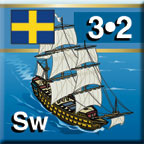| Soldier
Kings:
Toothless Lion of the North
By
Mike Bennighof, Ph.D.
November 2014
Have I really been at war with the Swedes?
—
Frederick of Prussia, to Swedish diplomats
requesting peace.
By the time of the Seven Years’ War,
Sweden had most definitely lost her Great
Power status, and her 17th-century title as
“Mistress of the Baltic” was on
its way out as well. The kingdom still ruled
Finland and Pomerania, but otherwise was confined
to its modern-day borders. That small economic
and population base did not yield the resources
for a struggle against much larger nations
at a time when war was becoming as much an
economic as a military contest.
Non-Swedish historians often mark the death
of Charles XII in 1718 as the end of Sweden’s
aggressive, expansionist stage. The kingdom
went to war three more times in the 18th century,
each time as an unprovoked aggressor.

The only real man
in Sweden?
In 1741, the Swedes attacked Russia at the
request of their French allies, in order to
divert Russian aid from Austria’s cause.
In 1757, with the Seven Years’ War under
way, they attacked Prussia, again at French
behest and over the strenuous objections of
Queen Luisa Ulrika, who favored the Prussian
side due to family loyalty (she was Frederick’s
sister), and who launched a failed coup to
restore royal power and bring Sweden into
the war on her brother’s side. In 1788,
King Gustav III launched an attack on Russia
all on his own, hoping to take advantage of
the diversion offered by Russia’s war
with Turkey.


In Soldier
Kings, our multi-player game of the
Seven Years’ War, Sweden has one fleet
and three armies. The ground forces are about
right: Sweden had a regular army of 50,000
men, of which about 15,000 operated in Pomerania
against the Prussians. They stumbled about
for four years, fighting several small battles
against the Prussian army and winning a galley
battle among the Pomeranian islands. After
the untimely death of Tsarina Elizabeth of
Russia in early 1762, the Swedes sued for
peace on the terms of “status quo ante
bellum,” which Frederick gladly accepted
after delivering his famous insult.

While the army pieces provided in Soldier
Kings are reasonable, Sweden receives
no leaders. The most notable of an unnotable
bunch was Gustaf David Hamilton (1699-1788),
who led the army out to seek battle and was
promptly defeated at Fehrbullin in 1758. Hamilton
was the grandson of Hugo Hamilton, a Scottish
mercenary officer in Swedish service, and
son of Malcolm Hamilton, who Charles XII tabbed
to lead the abortive Swedish expedition to
aid the Jacobite Rising of 1715 in Scotland.
Make Hamilton available as a new leader in
all scenarios.
In the game, Sweden receives one fleet,
a fairly weak 2-1 unit. This understates Swedish
seapower potential. Though the Swedish Navy
was at a low ebb during this period, Sweden
maintained the potential to build up her forces
relatively quickly and in the 1788 war sent
very large forces to sea. Even so, the Swedes
had up to a dozen ships of the line in operation,
and it appears a number more lay hulked at Karlskrona
and available for re-activation (though their
condition may have been questionable).
Add the two new fleet pieces to Sweden’s
available forces in all scenarios. They may
be built like any other minor country piece.

Sweden maintained two separate forces at
sea during this period: the Navy itself, and
the “Army Fleet,” or Skärgårdsflottan.
In 1756 this became a separate military branch,
finally re-uniting with the Navy in 1823.
The Skärgårdsflottan operated traditional
galleys and gunboats, as well as some unique
types the Swedes designed for in-shore use
like the “Archipelago Frigate,”
a shallow-draft, two-masted vessel bearing
heavy cannon in a broadside. The Army Fleet
operated among the many islands of the Finnish
and Pomeranian coasts with considerable success.
At the outbreak of the Seven Years’
War, this fleet numbered about 60 vessels
of all types, and was greatly strengthened
during the war with new construction. The
Swedes had two squadrons, one based at Stockholm,
the other at Sveaborg in Finland.
In game terms, add the two Swedish galley
fleets (the 2-2 pieces with the smaller ship
image) to Sweden’s initial forces in
all scenarios. A galley fleet may not intercept enemy
fleets in sea areas, but may be intercepted
itself. It may only initiate combat in a coastal
area. The Swedish galley fleets may only enter
the Baltic and coastal zones adjacent to it.
Download
the new Swedish pieces here!
Send the Swedes into action! Order Soldier Kings right now.
Mike Bennighof is president of Avalanche Press and holds a doctorate in history from Emory University. A Fulbright Scholar and award-winning journalist, he has published over 100 books, games and articles on historical subjects.
He lives in Birmingham, Alabama with his wife, three children and his dog, Leopold. |
